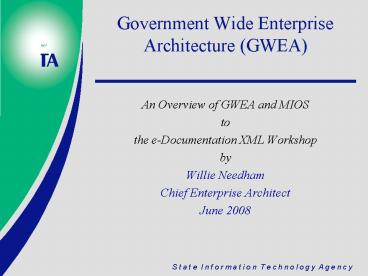Government Wide Enterprise Architecture GWEA - PowerPoint PPT Presentation
1 / 22
Title:
Government Wide Enterprise Architecture GWEA
Description:
S t a t e I n f o r m a t i o n T e c h n o l o g y A g e n c y ... 'It is astonishing what foolish things one can temporarily believe. if one thinks too long alone. ... – PowerPoint PPT presentation
Number of Views:247
Avg rating:3.0/5.0
Title: Government Wide Enterprise Architecture GWEA
1
Government Wide Enterprise Architecture (GWEA)
- An Overview of GWEA and MIOS
- to
- the e-Documentation XML Workshop
- by
- Willie Needham
- Chief Enterprise Architect
- June 2008
2
Agenda
- GWEA Motivation
- GWEA Strategic Intent
- Minimum Interoperability Standards (MIOS)
- Conclusion
By the time a man realizes that maybe his father
was right, he usually has a son who thinks he's
wrong. - Charles Wadsworth
3
GWEA Motivation
Everything should be made as simple as
possible, but not simpler. - Albert Einstein.
4
Government ICT House of Values
5
Mandated Services to Government
7.(6) The Agency SITA (a) must set standards
regarding- (i) the interoperability of
information systems subject to the approval of
the Minister and (ii) a comprehensive
information systems security environment for
departments, subject to the approval of the
Minister and the Minister of Intelligence
6
SITA Operating Model (Abridged)
7
Regulatory drivers
- Chapter 1, Part III.E Planning
- A head of department shall establish-
- an information plan that supports the processes
and objectives of the department. - an information technology plan that supports the
information plan and - an operational plan that enables the
implementation of the information technology plan
and information management. - Chapter 5, Part II e-Government
Interoperability - Comply with Minimum Interoperability Standards
(MIOS) for - every part of any new information system
developed or acquired for the public service or
any upgrade of any existing information system in
the public service and - every legacy system that is part of electronic
service delivery in the public service.
Public Service Regulations, 2001 (as amended)
8
Office of Gov CIO Priorities 08/09
- Information Management
- Enterprise Information Architecture (Data
Standards, Inventory of IM Initiatives, Shared
services and interoperability ) - Service Management
- Implement COBIT, ITIL process across public
sector - IT infrastructure application services
- Develop Government Wide Enterprise Architecture
to promote coherence, standardisation, eliminate
duplication and leverage ICT spend. - Integrated Finance Management System (IFMS)
- Next Generation e-Government system
Extract from Office of the Government CIO Plan,
Dec 2007
9
GWEA Strategic Intent
You cannot paint the 'Mona Lisa' by assigning
one dab each to a thousand painters. - William
Frank Buckley Jr.
10
EA Evolution / Revolution?
1990
2000
2010
11
Architecture in Context
12
An EA Capability (Function)
- EA Process
- EA Development Process
- EA Logic (Framework of Models)
- EA Methods (e.g. Techniques, Notation,
Principles, Trade-offs) - EA People
- Roles Responsibilities (RACI Contracts)
- Competencies
- Governance structures
- EA Information System
- Planning Modelling Software
- Data Repository
- ICT Infrastructure
- EA Products
- GWEA Reference Models / Blueprints / Plans
- Interoperability Standards
13
EA Process (TOGAF)
EA Framework Principles
Validate Requirement at every phase
Define EA Scope, Vision, Drivers and Baseline
Keep Architecture up to date
Ensure PROJECT Compliance to Architecture
Develop IMPLEMENTATION Roadmap
Identify PROJECT INITIATIVES
Accepted by the GITOC EA Committee in Nov 2007
14
EA Logic (Concept)
15
GWEA Governance Structure
Minister PSA
Other GITO Council Committees
SITA Exec
Gov CIO
GITO Council
EA Comm
GITO
42 Departments 9 Provinces
Gov Wide EA
Dept EA
National Department
16
GWEA Reference Model concept
Government Departments, Bodies Clusters
Business Process/Service Ref Model
IFMS, e-GOV, GIS, ECM, Cluster IS,
IS / ICT
NGN, Data Centres, Service Man, Security,
Dept EA / Master Systems Plans
17
GWEA Priorities
- Improve GWEA Framework v1.0
- Develop EA Handbook for Gov Depts.
- Develop GWEA Reference Models / Blueprints
- Improve Minimum Interoperability Standards
- Validate Departmental/Project EA Blueprints
- Establish an EA Centre of Excellence.
18
Interoperability and MIOS
"It is astonishing what foolish things one can
temporarily believe if one thinks too long
alone." - John Maynard Keynes
19
Interoperability levels
Cognitive Space ORG LEADERSHIP FOCUS AREA
IS/ICT Space MIOS FOCUS AREA
Tolk, Andreas. Beyond Technical
Interoperability Introducing a Reference Model
for Measures of Merit for Coalition
Interoperability.
20
MIOS v4.1 Status
- XML as a Standard
- XML (Extensible Mark-up Language) is the
cornerstone of the Government data presentation
and integration strategy but XML alone is not
sufficient. - Need to add XML data schemas for use throughout
the public sector. - Future version of MIOS (v5.0) will include
- Technical Reference Model (TRM) as reference and
classification schema for all interoperability
standards. - Government sector/cluster specific data
interoperability standards - Add a rationale to comply (applicability
clauses). - Implementation guidelines
- Improve the MIOS development process and
responsibilities. - Review Process and Frequency
- Annual basis through the GITOC Standing Committee
on Architecture with due process of consultation.
21
Conclusion
- National XML Standards prospective benefits
- Improve the interoperability maturity level among
government Information Systems - Enable e-Government programmes to proceed more
effectively and efficiently - Set a standard by which to certify the
acquisition of Government Information Systems - Whilst observing the following principles
- Collaborative process among Departmental
stakeholders (architects, software engineers and
managers) to strengthen collective ownership at
GITOC level - Maintain a balance between rigor and innovation
(Goldie Locks Tale) - Must be certifiable
- Must be manageable in its through-life of
existence and - Open freely available to public and private
entities to ensure transparency and competitive
bidding.
22
Thank YouDankieSiyabongaKe a
lebohaSiyathokoza
Willie Needham Chief Enterprise Architect
(GWEA) Strategic Services State IT Agency (Pty)
Ltd 459 Tsitsa St. Erasmuskloof Pretoria, South
Africa E-mail willie.needham_at_sita.co.za Tel 27
(12) 482 2774 Web www.sita.co.za































